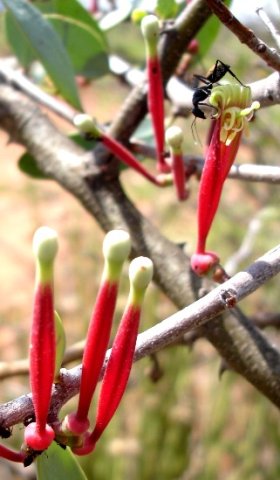Tapinanthus oleifolius flowers and hungry ant

The flowers of Tapinanthus oleifolius grow on petioles that are nearly absent on some plants, more than 1 cm long on others. An inflorescence may comprise one or several umbels. The perianth tube of the individual flower is long, narrow and erect. This tube may be longer than 4 cm, red with some whitish spots. The unopened buds are cream or pale green in colour, shaped in the image of a safety match. The ovary at the base is bulbous. Once open, the protruding anthers on red filaments are conspicuous on the flower, as is the stigma.
Flowers attract pollinators effectively in winter grey when many tall trees have dropped their leaves, but some grow patches of these eye-catching parasite flowers high up among bare branches. The popular red berry likewise is welcome food in the season of scarcity. This sticky fruit, craved by birds, facilitates the free rides that constitute a good example of efficient seed dispersal.
This plant was seen flowering in December near Olifantshoek in the Northern Cape (www.plantzafrica.com).

